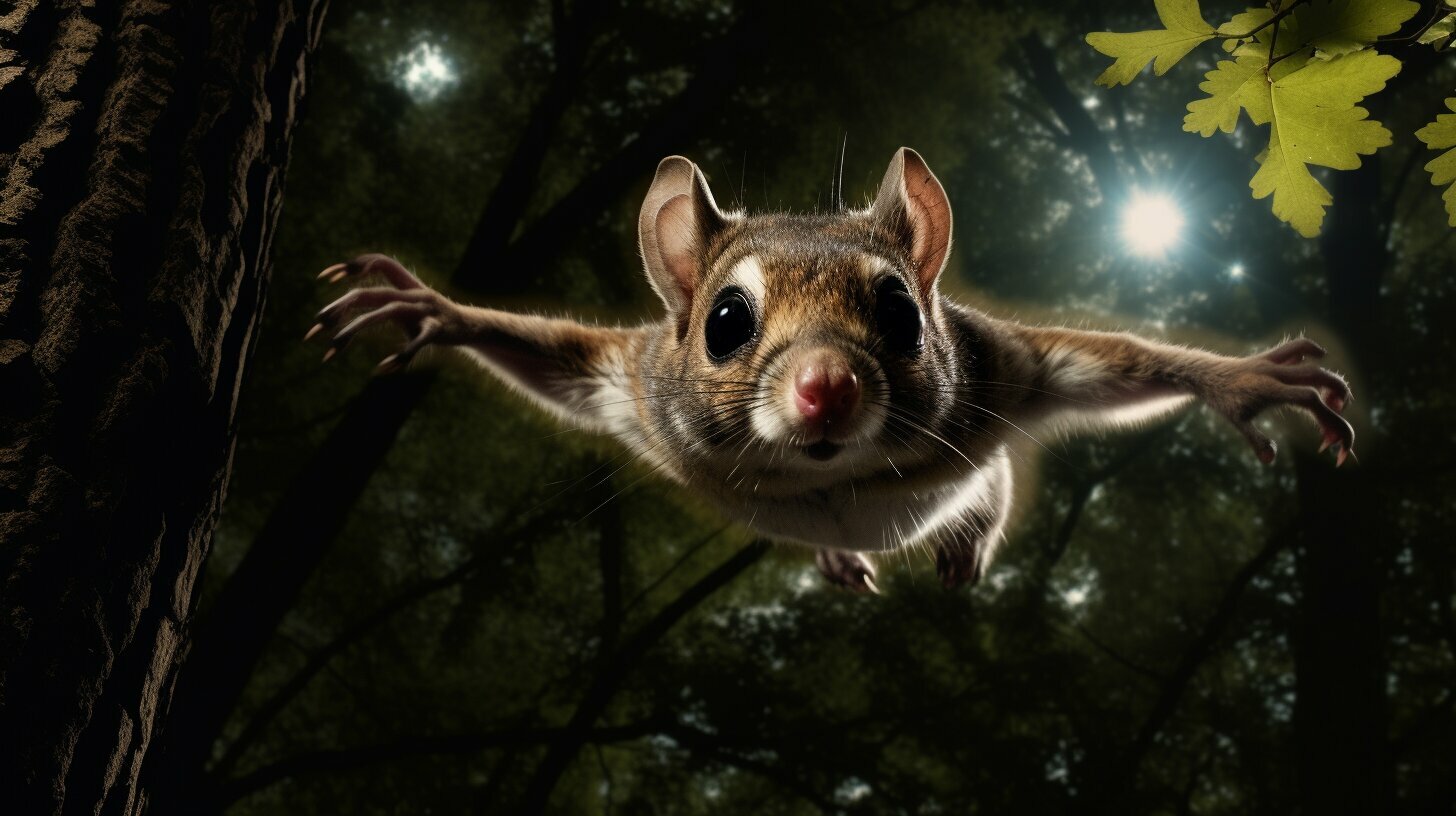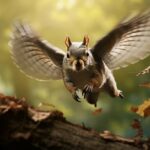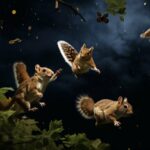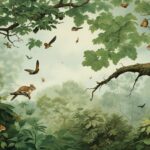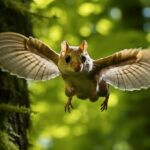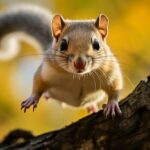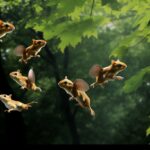Flying squirrels are incredible creatures that possess unique abilities that allow them to glide through the air. Unlike true flyers like bats, these fascinating critters rely on a special membrane between their limbs called a patagium to navigate the skies. With 43 different species found across Asia, Europe, and North America, flying squirrels exhibit a range of interesting characteristics that make them a captivating subject of study.
Key Takeaways:
- Flying squirrels have a unique gliding ability, using a patagium to soar through the air.
- They are not true flyers like bats, but their gliding abilities are impressive.
- There are 43 species of flying squirrels found across Asia, Europe, and North America.
- They have big, round eyes that help them see in the dark while they glide and forage for food.
- Some species of flying squirrels have been found to glow at night, although the reason behind this phenomenon remains unknown.
Flying Squirrel Habitat and Behavior
Flying squirrels are found across Asia, Europe, and North America, inhabiting various forested areas. These nocturnal creatures have adapted to live in a range of habitats, including deciduous and coniferous forests, as well as mixed woodlands. They are highly skilled climbers and can be found dwelling in tree hollows, nests, and even birdhouses.
When it comes to behavior, flying squirrels are known for their gliding abilities. They have a unique adaptation that allows them to glide through the air, using the membrane between their limbs called a patagium. This extraordinary feature enables them to travel between trees, covering impressive distances in the process.
Their gliding technique involves leaping off from a high point, spreading their arms and legs, and using their fluffy tails to steer. It’s a graceful sight to behold as they effortlessly navigate through the air. Flying squirrels are mainly active at night, spending their days resting in tree cavities or nests made of leaves, twigs, and bark.
These agile creatures have a diverse diet consisting of fruits, nuts, seeds, and insects. They are known to store food for the winter by burying nuts and seeds in various locations. This behavior helps them survive during times of scarcity. Flying squirrels also display a unique social structure, with some species living in small family groups, while others are solitary.
| Key Points | Flying Squirrel Habitat and Behavior |
|---|---|
| Geographic Distribution | Asia, Europe, and North America |
| Habitat | Forested areas, including deciduous and coniferous forests |
| Main Adaptation | Patagium membrane for gliding |
| Nocturnal Behavior | Active during the night, resting in tree cavities during the day |
| Diet | Fruits, nuts, seeds, and insects; food caching behavior |
Different Flying Squirrel Species
There are a total of 43 species of flying squirrels, each with unique traits and adaptations. Let’s take a closer look at a few fascinating species:
Siberian Flying Squirrel
| Species | Scientific Name | Native Habitat | Notable Feature |
|---|---|---|---|
| Siberian Flying Squirrel | Pteromys volans | Siberia, northeastern Asia, and Europe | This species is known for its ability to hibernate for up to 240 days during the winter. |
The Siberian flying squirrel is an adaptive creature that thrives in cold climates. Its large, bushy tail helps it maintain balance during glides, while its dense fur keeps it warm in sub-zero temperatures. They often build nests in coniferous trees and rely on fungi as a key food source.
Maharashtra Giant Flying Squirrel
| Species | Scientific Name | Native Habitat | Notable Feature |
|---|---|---|---|
| Maharashtra Giant Flying Squirrel | Petaurista philippensis | Western Ghats, India | This species is recognized for its striking black and golden fur and is the largest flying squirrel in India. |
The Maharashtra giant flying squirrel is an arboreal species, spending most of its life high up in the canopy. It has a varied diet, feeding on fruits, nuts, leaves, and even bird eggs. The elongated limb bones and large patagium of this species enable it to glide effortlessly through the forest.
Northern Flying Squirrel
| Species | Scientific Name | Native Habitat | Notable Feature |
|---|---|---|---|
| Northern Flying Squirrel | Glaucomys sabrinus | North America | This species is known for its ability to glide long distances, covering up to 65 feet in a single glide. |
The northern flying squirrel is one of the most common flying squirrel species in North America. It prefers mature coniferous or mixed forests and relies on a diet of nuts, seeds, fungi, and lichens. These squirrels are excellent climbers and can easily access treetops to launch their glides.
These are just a few examples of the diverse species of flying squirrels. Each species has its own adaptations and behaviors that allow it to thrive in its particular habitat. Exploring the world of flying squirrels offers a fascinating glimpse into the wonders of nature and the incredible diversity of our planet.
Flying Squirrel Diet and Adaptations
Flying squirrels have a varied diet consisting of nuts, seeds, fruits, and insects, which provides them with the energy they need for their gliding escapades. Their ability to glide through the air requires a lot of energy, and their diet plays a crucial role in sustaining their active lifestyle.
These agile creatures are well-equipped for their dietary needs with a set of adaptations that allow them to thrive in their environment. Their sharp incisor teeth enable them to crack open nuts and seeds, while their strong jaws allow them to chew through tough outer shells. They have a remarkable digestive system that allows them to efficiently extract nutrients from their food, ensuring optimal energy levels for their acrobatic gliding maneuvers.
Additionally, flying squirrels possess adaptations that aid in their foraging habits. Their keen sense of smell helps them locate sources of food, while their nimble limbs and sharp claws allow them to climb trees and maneuver through branches with ease. These adaptations, combined with their ability to glide, give flying squirrels a distinct advantage in accessing food sources that are otherwise inaccessible to other arboreal mammals.
| Common Food Choices | Benefits |
|---|---|
| Nuts (acorns, walnuts, hazelnuts) | Rich in fats and proteins, providing sustained energy |
| Seeds (pine cones, maple seeds) | High in essential nutrients and oils |
| Fruits (berries, apples, cherries) | Source of vitamins and natural sugars |
| Insects (moths, beetles, caterpillars) | Excellent source of protein |
It is fascinating to witness how flying squirrels have adapted to their environment, both anatomically and behaviorally, in order to thrive and survive. Their specialized diet and remarkable adaptations have allowed these aerial acrobats to conquer the heights and flourish in their forest homes.
Anatomy of a Flying Squirrel
Flying squirrels possess a special membrane called a patagium that stretches from their wrists to their ankles, allowing them to glide with precision. This incredible adaptation sets them apart from other squirrels and enables them to effortlessly navigate through the air. The patagium acts as a parachute-like wing, providing the necessary support and surface area for gliding. It is made up of a thin layer of skin that is connected to elongated cartilage, forming a framework for the wing-like structure.
Within the patagium, flying squirrels have a network of muscles that allow them to control their movements while gliding. By adjusting the tension and position of their limbs, they can change the shape and angle of their gliding surface, altering their trajectory as needed. This remarkable level of control enables them to soar through the treetops, maneuver around obstacles, and land with great precision.
Not only do flying squirrels have impressive gliding adaptations, but they also possess other anatomical features that contribute to their aerial abilities. Their limbs are slender and lightweight, minimizing drag and facilitating efficient gliding. Additionally, their tails play a crucial role in stabilization during flight. The tail acts as a rudder, helping the squirrel maintain balance and control while airborne.
| Key Anatomy of a Flying Squirrel | Description |
|---|---|
| Patagium | A specialized membrane that extends from the wrists to the ankles, enabling gliding. |
| Muscles | A network of muscles within the patagium that allows for precise control and maneuverability in flight. |
| Limbs | Slender and lightweight limbs that minimize drag during gliding. |
| Tail | Plays a crucial role in stabilizing the squirrel during flight, acting as a rudder. |
The unique anatomy of flying squirrels showcases the remarkable adaptations necessary for their airborne lifestyle. Their patagium, muscles, limbs, and tail all work together to ensure smooth and efficient gliding, allowing them to navigate their forest habitats with ease.
Fascinating Fun Facts about Flying Squirrels
Did you know that some species of flying squirrels have been found to glow at night, emitting a pink hue? This peculiar phenomenon has baffled scientists for years, and the exact reason behind their bioluminescence remains unknown. Imagine spotting these enchanting creatures as they glide through the darkness, their soft pink glow illuminating the night sky.
Flying squirrels are not only unique in their ability to emit a glowing light but also in their gliding capabilities. While they may not possess the power of true flight like birds or bats, their parachute-like membrane, known as a patagium, allows them to gracefully soar through the air. With a wingspan of up to five feet, they can cover impressive distances during their nocturnal escapades, reaching up to 65 feet in a single glide.
These adorable creatures are found in various parts of the world, with 43 known species inhabiting Asia, Europe, and North America. While some reside primarily in Asia, North America is home to three remarkable species of flying squirrels—the Northern flying squirrel, the Southern flying squirrel, and the endangered Carolina northern flying squirrel.
In addition to their gliding abilities, flying squirrels possess captivating adaptations that help them survive in their natural habitats. Their large, round eyes enable them to navigate through the darkness, searching for food and avoiding predators. They have a unique parenting style, with babies staying with their mothers for several months before becoming independent. Despite their inherent cuteness, flying squirrels are preyed upon by owls, raccoons, and snakes, adding to the challenges they face in their daily lives.
To protect these elusive and enchanting creatures, it’s important to learn more about them and spread awareness. Social media can be a powerful tool for raising awareness, sharing fun facts, and promoting conservation efforts. Supporting initiatives that aim to conserve their habitats and planting trees for their survival can also make a significant impact in their protection. So, let’s celebrate the wonder of flying squirrels and work together to ensure their continued existence in the wild.
| Flying Squirrels Facts | |
|---|---|
| Species of Flying Squirrels | 43 |
| Wingspan | Up to 5 feet |
| Average Glide Distance | Up to 65 feet |
| Main Habitat | Asia, Europe, and North America |
| Unique Adaptation | Ability to emit a pink glow at night |
| Common Predators | Owls, raccoons, and snakes |
Supporting the Conservation of Flying Squirrels
To protect these adorable and elusive creatures, we can raise awareness, support conservation initiatives, and promote the planting of trees essential for their survival.
Flying squirrels are facing numerous threats to their habitats, including deforestation and urbanization. By spreading awareness about the importance of their conservation, we can garner support and encourage others to take action. Share fascinating facts about flying squirrels on social media or start a conversation with friends and family. Remember, knowledge is power, and by educating others, we can help safeguard these remarkable creatures.
Supporting conservation initiatives is another crucial step in preserving flying squirrel populations. There are several organizations dedicated to protecting these unique animals and their habitats. Consider donating to these organizations or volunteering your time to support their efforts. By contributing, you can directly impact the conservation projects that focus on protecting and restoring flying squirrel habitats.
Planting trees is vital for the survival of flying squirrels. These arboreal mammals rely on trees for food, shelter, and nesting sites. Participate in local tree planting events or start your own initiative to ensure there are plenty of suitable habitats for flying squirrels to thrive. By providing them with a sustainable environment, we can help secure their future.
| Ways to Support Flying Squirrel Conservation |
|---|
| Raise awareness through social media and conversations |
| Donate to conservation organizations |
| Volunteer for conservation initiatives |
| Participate in tree planting events |
| Start your own tree planting initiative |
By taking these actions, we can contribute to the conservation of flying squirrels and ensure their continued existence in the wild. Remember, every effort counts, no matter how small. Together, we can make a difference and protect these incredible creatures for generations to come.
Conclusion
Flying squirrels are truly remarkable creatures, and by learning about them and supporting their conservation, we can play a vital role in preserving their existence.
These fascinating creatures have the ability to glide through the air using a special membrane between their limbs. While they’re not true flyers like bats, their gliding abilities are impressive. With 43 species found across Asia, Europe, and North America, they have adapted to various habitats and behaviors.
With big, round eyes that help them see in the dark, flying squirrels glide and forage for food. Some species even have the unique ability to glow at night, although the reason behind this phenomenon remains unknown. Their parachute-like membrane, known as a patagium, allows them to cover impressive distances in the air, with the average glide reaching up to 65 feet for the Northern flying squirrel.
Flying squirrels have been around for millions of years and are primarily nocturnal, making them elusive to spot. They face threats from predators such as owls, raccoons, and snakes. These creatures have a unique parenting style, with babies staying with their mothers for several months before becoming independent.
To help protect these cute and elusive creatures, it’s important to spread awareness and knowledge about them. Share interesting flying squirrel facts on social media, support initiatives that conserve their habitats, and contribute to planting new trees for their survival. By doing so, we can make a difference and ensure the continued existence of these amazing flying squirrels.
Is It True That Koalas Have Pouches Just Like Kangaroos?
Koalas’ pouches and a fascinating fact: Contrary to popular belief, koalas do not have pouches like kangaroos. While kangaroos use their pouches to carry and protect their young, koalas do not possess this unique feature. However, one intriguing fact is that female koalas have a forward-facing pouch, which safeguards their tiny joeys during development.
What Is the Average Lifespan of a Flying Squirrel?
The average lifespan of a flying squirrel can range from 5 to 6 years in the wild. However, in captivity, these small rodents may live up to 10 years under proper care. Factors such as predation, habitat loss, and availability of food sources contribute to their shorter lifespans in the wild.
FAQ
Q: How many species of flying squirrels are there?
A: There are 43 species of flying squirrels found across Asia, Europe, and North America.
Q: Can flying squirrels truly fly?
A: Flying squirrels cannot fly like bats, but they can glide through the air using a special membrane between their limbs.
Q: How far can flying squirrels glide?
A: The average glide of a flying squirrel can reach up to 65 feet for the Northern flying squirrel.
Q: Where are flying squirrels primarily found?
A: Flying squirrels are mainly found in Asia, although there are three species in North America.
Q: Are flying squirrels nocturnal?
A: Yes, flying squirrels are primarily nocturnal creatures.
Q: What are the predators of flying squirrels?
A: Flying squirrels have several predators, including owls, raccoons, and snakes.
Q: How long do baby flying squirrels stay with their mothers?
A: Baby flying squirrels stay with their mothers for several months before becoming independent.
Q: Why do some species of flying squirrels glow at night?
A: Although the reason behind this glowing phenomenon is still unknown, some species of flying squirrels have been found to emit a pink hue at night.
Q: How can I help protect flying squirrels?
A: You can help protect flying squirrels by learning more about them, spreading awareness on social media, and supporting initiatives that aim to conserve their habitats and plant new trees for their survival.

